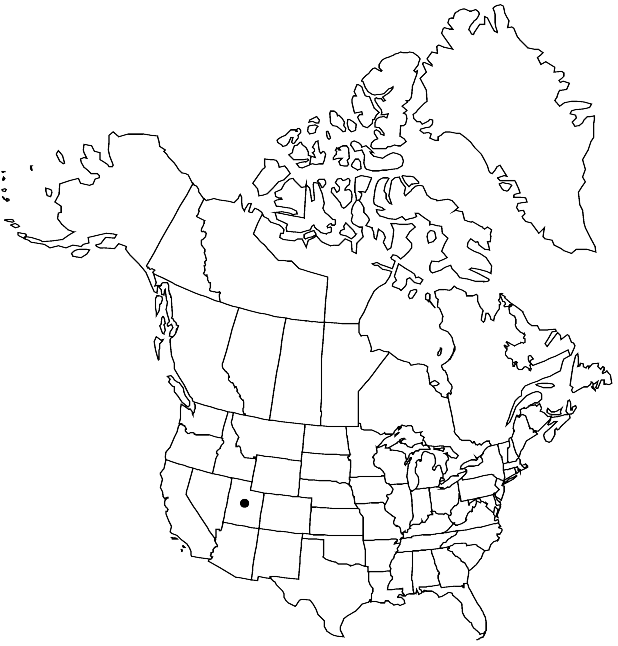Difference between revisions of "Physaria tumulosa"
Novon 12: 328. 2002.
FNA>Volume Importer |
imported>Volume Importer |
||
| (6 intermediate revisions by 2 users not shown) | |||
| Line 8: | Line 8: | ||
}} | }} | ||
|common_names=Kodachrome bladderpod | |common_names=Kodachrome bladderpod | ||
| − | |basionyms={{Treatment/ID/ | + | |basionyms={{Treatment/ID/Basionym |
|name=Lesquerella hitchcockii subsp. tumulosa | |name=Lesquerella hitchcockii subsp. tumulosa | ||
|authority=Barneby | |authority=Barneby | ||
| + | |rank=subspecies | ||
| + | |publication_title=Leafl. W. Bot. | ||
| + | |publication_place=10: 313. 1966 | ||
}} | }} | ||
|synonyms={{Treatment/ID/Synonym | |synonyms={{Treatment/ID/Synonym | ||
|name=Lesquerella tumulosa | |name=Lesquerella tumulosa | ||
|authority=(Barneby) Reveal | |authority=(Barneby) Reveal | ||
| − | }}{{Treatment/ID/Synonym | + | |rank=species |
| + | }} {{Treatment/ID/Synonym | ||
|name=Physaria rubicundula var. tumulosa | |name=Physaria rubicundula var. tumulosa | ||
|authority=(Barneby) S. L. Welsh | |authority=(Barneby) S. L. Welsh | ||
| + | |rank=variety | ||
}} | }} | ||
|hierarchy=Brassicaceae;Brassicaceae tribe Physarieae;Physaria;Physaria tumulosa | |hierarchy=Brassicaceae;Brassicaceae tribe Physarieae;Physaria;Physaria tumulosa | ||
| Line 34: | Line 39: | ||
|distribution=Utah. | |distribution=Utah. | ||
|discussion=<p>Of conservation concern.</p><!-- | |discussion=<p>Of conservation concern.</p><!-- | ||
| − | --><p>Physaria tumulosa is morphologically similar to 55. P. navajoensis of northeastern Arizona and northwestern New Mexico, and differing very subtly. It has been long treated as an infraspecific taxon of P. hitchcockii; unpublished molecular data do not support that disposition. It is found on knolls of the Winsor Member of the Carmel Formation.</p> | + | --><p><i>Physaria tumulosa</i> is morphologically similar to 55. <i>P. navajoensis</i> of northeastern Arizona and northwestern New Mexico, and differing very subtly. It has been long treated as an infraspecific taxon of <i>P. hitchcockii</i>; unpublished molecular data do not support that disposition. It is found on knolls of the Winsor Member of the Carmel Formation.</p> |
|tables= | |tables= | ||
|references= | |references= | ||
| Line 43: | Line 48: | ||
-->{{#Taxon: | -->{{#Taxon: | ||
name=Physaria tumulosa | name=Physaria tumulosa | ||
| − | |||
|authority=(Barneby) O’Kane & Al-Shehbaz | |authority=(Barneby) O’Kane & Al-Shehbaz | ||
|rank=species | |rank=species | ||
| Line 58: | Line 62: | ||
|publication year=2002 | |publication year=2002 | ||
|special status= | |special status= | ||
| − | |source xml=https:// | + | |source xml=https://bitbucket.org/aafc-mbb/fna-data-curation/src/2e0870ddd59836b60bcf96646a41e87ea5a5943a/coarse_grained_fna_xml/V7/V7_1135.xml |
|tribe=Brassicaceae tribe Physarieae | |tribe=Brassicaceae tribe Physarieae | ||
|genus=Physaria | |genus=Physaria | ||
Latest revision as of 22:30, 5 November 2020
Perennials; caudex (buried), branched, (forming hard mats); densely pubescent, trichomes several-rayed, rays furcate or bifurcate, (tuberculate). Stems several from base, erect, (unbranched), 0.2–0.3 dm. Basal leaves (few), similar to cauline. Cauline leaves: (petiole not differentiated from blade); blade (somewhat succulent), linear to narrowly oblanceolate, 5–12 mm, margins entire. Racemes dense, (few-flowered). Fruiting pedicels (ascending to divaricate-ascending, ± straight), 3.5–6 mm. Flowers: sepals (yellowish), elliptic, 3–4.5 mm; petals (erect or, more commonly, arching), spatulate to oblanceolate, 5.8–7 mm, (claw not or weakly differentiated from blade). Fruits (coppery or reddish brown in age), broadly ovoid, slightly inflated, 3–4 mm; valves (not retaining seeds after dehiscence), glabrous throughout; replum as wide as or wider than fruit; ovules 4–8 per ovary; style 1.8–3 mm. Seeds flattened.
Phenology: Flowering May–Jun.
Habitat: Barren white knolls surrounded by sagebrush, pinyon pine, and Utah juniper
Elevation: 1600-1800 m
Discussion
Of conservation concern.
Physaria tumulosa is morphologically similar to 55. P. navajoensis of northeastern Arizona and northwestern New Mexico, and differing very subtly. It has been long treated as an infraspecific taxon of P. hitchcockii; unpublished molecular data do not support that disposition. It is found on knolls of the Winsor Member of the Carmel Formation.
Selected References
None.
